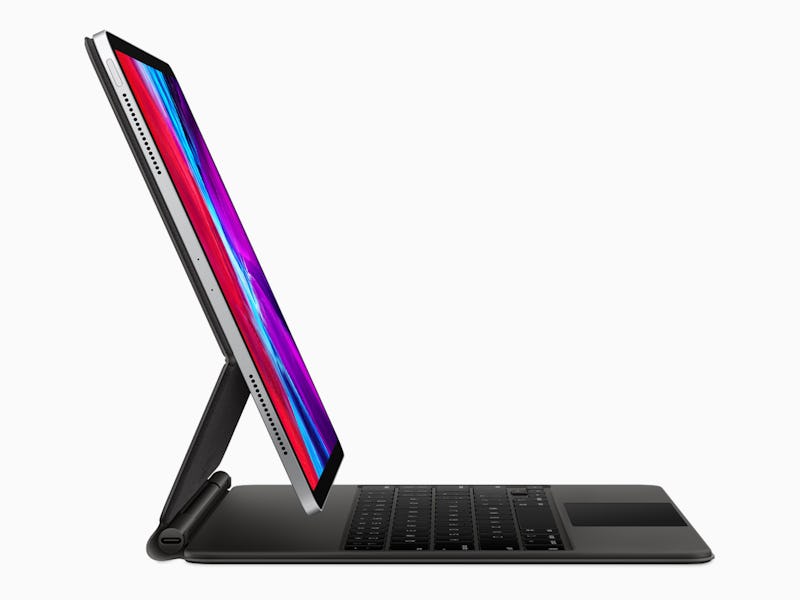The iPad is quietly surging to cement Apple's future vision of computers
In a mixed quarterly earnings report, Apple's iPad stood out as one of the big winners.

The iPad, Apple's decade-old tablet, is transforming itself from not-quite-a-smartphone into a key vision for the future of computing.
During the company's second-quarter 2020 earnings call Thursday, CEO Tim Cook outlined how Apple is rapidly deploying the iPad to school systems, including an order of 350,000 to New York City that's the largest such order in history. Around half of buyers of the iPad and Mac during the quarter were first-time buyers, and the number of people using the products reached an all-time high. Customer satisfaction for the iPad and Mac also ranked high, at 95 and 96 percent respectively.
The coronavirus pandemic has further transformed the conversation around the products. Cook explained how hospitals are using iPhone and iPad apps to support patients. As more consumers take online classes or work remotely, Cook said he expected iPad and Mac revenue to increase year-over-year for the next quarter, unlike the iPhone and wearables that are expected to decline.
These positive results come at a critical time for the iPad, as it gradually receives more features that make it suitable as a user's primary computer. Apple released an ad last month demonstrating how the iPad breaks with conventional expectations about a computer: it has cellular, it supports a wide range of uses, it doesn't use a traditional windowing system...while traditional computers involve sitting at a desk or getting a lap ready, the iPad's design enables users to just pick up and get going wherever.
Apple has been following this path for a while. Former CEO Steve Jobs likened the iPad in 2010 to a car, while older laptops were trucks – great for work, used to be the majority of vehicles on the road, but these days most people find a car suits their needs fine. In 2017 Apple released an iPad ad in a similar vein to its most recent, albeit with a slightly more confused tone as the main character asks "what's a computer?"
In March, Apple announced the fourth-generation iPad Pro, which adds a second rear camera lens and a lidar sensor – the sort used for depth sensing in autonomous cars. These features boost augmented reality, which Cook has previously described as an exciting area of research for Apple. While the Mac has a single front-facing camera for grainy video calls with colleagues, the iPad allows users to step into virtual worlds and explore new creative possibilities. When paired with the touchscreen and Apple Pencil stylus, the iPad seems to offer a wealth of options for designers and artists.
Alongside the new iPad, Apple also released the Magic Keyboard. Its $299 starting price has been criticized, but its contribution to Apple's tablet has been praised. Magnetically holding the iPad above a keyboard using a cantilevered hinge, the Magic Keyboard offers a more MacBook-like form factor while retaining the ability to quickly switch back to tablet form. After the product started shipping in April, the iPad suddenly started to seem more Mac-like.
The fourth-generation iPad Pro and the Magic Keyboard.
On the software side, Apple is making moves that open up the iPad to more possibilities. This was perhaps best highlighted with iPadOS 13, which launched last September, a rebranding that signaled Apple's intention to move the iPad further from the iOS software used on the iPhone.
Already the first shoots of divergence are taking shape. Version 13.0 included support for external screens, external mass storage devices, better multitasking, permanent home screen widgets for more information at a glance, and more. Version 13.4 introduced mouse support in time for the Magic Keyboard, but instead uses a circle that transforms based on context rather than a standard cursor. Apple's Worldwide Developers Conference in June is expected to feature iPadOS 14, where the software could take on even more Mac-like roles.
The Inverse analysis – The iPad has traditionally occupied a sort of midpoint in Apple's product line, somewhere between an iPhone and a Mac. But with Apple's latest moves on hardware and software, the iPad is able to replace a computer in more situations than before. The company's latest earnings show schools, hospitals, and general consumers are all reacting positively to the iPad, and more people are using one than before.
There's still some missing elements like better external screen support and multitasking capabilities, but Apple's future direction with the iPad could leave even more questioning whether they need a traditional computer any more.